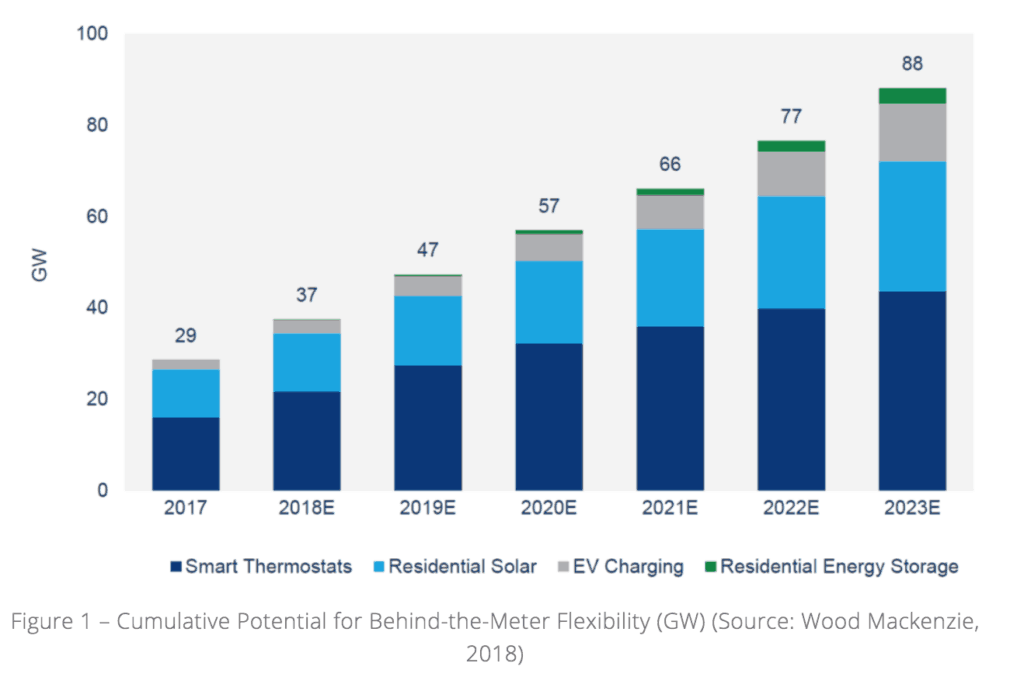This article as originally published on the SEPA blog.
It is unsurprising to utility professionals that the uptake of distributed energy resources (DERs) – such as smart thermostats, electric vehicles, solar PV, and batteries – is continuing to surge. Over the next five years, Navigant estimates utilities in North America will spend around $1B on residential DER programs, which Wood Mackenzie expects could unlock an additional 50GW of flexibility in the U.S. power system. While promising, can utilities combine the use of these resources to further maximize the benefits?

Many standalone DER use cases exist (see figure 2), but tend to only leverage the potential of DERs for a small period of time. However, when multiple use cases are satisfied concurrently, the associated “value stacking” can significantly improve the economics and return on investment.
Value stacking is defined as the bundling of grid applications, creating multiple value streams, which can improve the economics for distributed energy resources. Bundling grid applications to stack multiple values can improve the economics for DER technology investments by improving the return on investment and reducing the payback period. (Source: Smart Electric Power Alliance, 2017)

Realizing value stacking today
One of the biggest challenges for utilities is integrating the value of DER programs with existing business models. Examples can include separate funding sources, out of sync timelines to realize funds, differing capitalization eligibility, competing resource constraints, and disconnected internal teams. That said, the industry is evolving, and programs like New York’s Reforming the Energy Vision (NY-REV) are helping take the concept of value stacking from pilots to full deployments.
Utility-run smart thermostat programs, which deliver demand response (DR) and energy efficiency (EE) benefits, offer an illustrative example of value stacking. While DR events supply meaningful value to the utility by shifting load from peak periods, they only occur approximately 10-12 times over a typical summer. However, optimizing HVAC operation on non-DR event days unlocks additional value for both utilities and customers via reduced energy consumption. For instance, The Peak Load Management Alliance recently recognized AEP Indiana Michigan Power for their ability to provide 80% load shed during DR events and up to 50% runtime reduction of HVAC on EE days, without sacrificing customer comfort.
Co-optimizing DER with TOU
Through time-of-use (TOU) rates for residential customers, utilities can orchestrate DERs to deliver a combination of DR capability, rate optimization (and cost savings), and increased customer satisfaction. TOU rates optimize the operating schedule of resources via an adjusted price signal; for instance, pre-cooling homes during off-peak periods, or charging electric vehicles in the late evening after the peak window ends. Similar to the AEP Indiana Michigan Power example, coordinating multiple DERs at a household can compound benefits by co-optimizing schedules to avoid coincident operation and subsequent peaks. This also unlocks a DR resource for the days it’s needed.

Leveraging analytics to unlock greater value
Utilities can create additional value by disaggregating household load into end-uses and appliances using smart meter/AMI interval data. By providing visibility into the times non-controlled appliances are operating – such as pool pumps, dishwashers or dryers – an intelligent home energy management system can limit coincident peaks by curtailing or pausing the appliances it can control.
Importantly, utilities don’t have to control every load in a household. Controlling the significant discretionary loads, such as HVAC, water heaters, and electric vehicles is enough to effectively co-optimize.

While the focus during the design phase of any demand side management program is on a single use case to achieve a specific operational outcome, this is an important time to identify parallel opportunities for value stacking. The launch of a new program is a critical time for utilities to engage with customers and improve satisfaction and digital engagement. In order to bundle uses cases in a single demand side management program, utilities need a comprehensive plan that uses effective customer engagement, activation and orchestration tools.
Despite the challenges of DER value stacking, a growing number of innovative utilities are realizing the benefits and are moving beyond pilots into full implementations. Ultimately, the ongoing surge in DER deployment will require DER value stacking for planning and operating a modern grid.




